#adyton
Explore tagged Tumblr posts
Text

Today's Flickr photo with the most hits: chisel marks on the masonry walls of the corridor leading from the pronaos to the adyton, Temple of Apollo at Didyma.
3 notes
·
View notes
Text

Tyche
Altar with the Tyche of Berytus flanked by lions, from the adyton of Temple A at Niha, Lebanon, Roman imperial period, 3rd c. CE, limestone
National Museum of Beirut, Lebanon, Inv. 2057
22 notes
·
View notes
Text
The myth of Dionysos (3)
For the previous posts, see here and here.

V) The cult of Dionysos : Outside the city, inside the city
Such a god apparently does not have his place in the Ancient Greek city. Séchan-Lévêque reminds us that his religion, at the same time joyful and wild, is centered around the “thiasus”, that is to say a gathering of male and female beings joining outside of any civic or familial setting. According to Euripides’ description and to the various visual depictions of Ancient Greece, all the cultural elements surrounding Dionysos are the very opposite of the rational organization of a State. His cult takes place on the countryside, in woods and mountains. It takes place at night. The participants wear an animal skins over their clothes (or replacing their chiton), their hair is wild or crowned by ivy or laurel, their belt is made of a snake or a baby leopard hangs from it ; in one hand they hold the thyrsus and in the other a small animal (hare or young fawn). The music played for Dionysos is strange: flutes, tympanum and castanets. His ceremonies are chaotic: wild dances, convulsions, exhausting races. His sacrifice is performed by ripping apart animals before eating their raw flesh. The thiasus could be made of men, but the most famous of all the thiasus is the female one, and its members are called the Menads, the Bacchants, the Thyads, the Bassarides… Ordinarily, women of Ancient Greece were locked up inside the gynaeceum, so to have them becoming wild and savage makes the cult of Dionysos a unique one, set apart by the official religious events of the city, since he breaks all urban religious rules. Similarly, the mysteries of Dionysos unite together men and women, citizens and slaves, which meant breaking apart the Ancient Greek social hierarchy.
And yet, this Dionysos that destroys the order of the city is greatly honored at Delphi, the domain of the Greekest of all gods, Apollo. The Pythia reminds the audience, in Aeschylus’ Eumenids, that she honors the nymphs over which rules Bromios and his Bacchants, with explicit references to the story of Pentheus. Every year, during the three months of winter, while Apollo leaves for Hyperborea, Dionysos replaces him. And every two years, the Thyads of Delphi and the Bacchants of Athens, holding torches, celebrate on mount Parnassus the son of Semele. In the adyton of Apollo’s temple, legends claimed Dionysos’ tomb could be found. The poets frequently exchanged the names and nicknames of the two deities: Aeschylus wrote in Bassarids of “Apollo with ivy, a bacchant and a seer”, while Euripides in Likymnion wrote of “Lord Bakchos, friend of the laurel, Pean-Apollon with the beautiful lyre”. As such, despite Nietzsche’s strict opposition between the god of harmonious restraint and the deity of savage drunkenness, the two gods are actually far from being polar opposites.
Dionysos also finds a home at Athens. We already saw several of the festivals in his honor there: Apaturia, Anthesteria, Oschophoria… But to those can be added the agrarian Dionysia, the the Lenaia, and especially the great Dionysia: during those, contests of dithyrambic, of tragedies and of comedies were held, gathering an audience coming from all four corners of Greece. Traditionally, the tragedy, the “tragodia”, is read as meaning “the song of the goat”, tragou-ôdè, since the goat was the animal traditionally sacrificed to the god. During the first day of the Great Dionysia, the statue of Dionysos was carried inside the “orchestra”, at the very heart of the city. And during the contests, a place of honor was kept for the priest of Dionysos. The marginal god clearly earned his place among men and Olympians.
Because, according to the Bacchants, inside the Dionysian chaos, there si a superior order, an “eukosmia” that unfortunately Pentheus fails to see, since he is a young tyrant filled with hubris. However the wise rulers of Athens did perceive and honor this superior order – unlike the Roman Senators that, in 186 BCE, harshly repressed any participations to the Bacchanals.
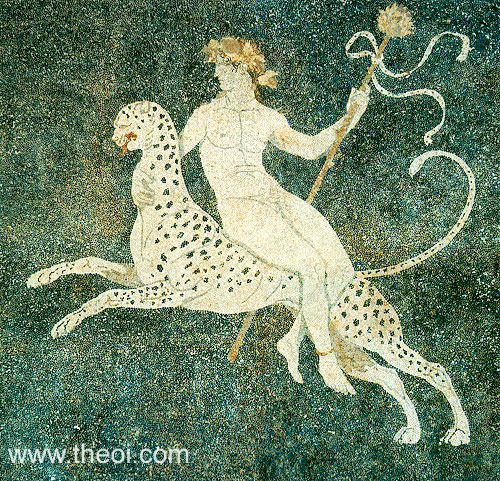
VI) Dionysos in service of political and religious doctrines: various uses
Multiple, complex, contradictory and shapeshifting: the god offered to the political and religious domains a very malleable material. For example, there are obvious links and mutual influences between the eastward journey of Dionysos and the eastward journey of Alexander. Alexander, just like his soldiers, and just like his historians, know of the story of the god’s travel to the East – the Dionysos of Euripides, in the Bacchants, said himself: “I left Lydia with his gold-fertile fields, I left the plains of Phrygia for the sun-burned plateaus of Persia, the walled cities of Bactrian, and the land of the Medes, frozen by winter ; and happy Arabia ; and finally all of Asia, laying by the salted waters…” Alexander took his army on the very steps of Dionysos. Of course, the Great was going to make the god the patron of his expedition, and as such Alexander was celebrated as the “new Dionysos” (a title that future rulers of Alexandria will also bear). The parallel grows stronger with the encounter by Alexander’s army of a town named Nysa, located near the mount Meros (a word that sounds similar to the Greek word for “thigh”) – the prince claimed the people of Nysa were descendants of the Greek people that Dionysos took with his on his own journey. However, in a complete circle, the adventure of Alexander the Great influenced greatly Dionysos’ own travels. India, for example, was never named in the tale of the Bacchants. But after the exploits of Alexander, Dionysos became the conqueror of India. Poets, painters and sculptors all depicted him taking part in this “war of India” that Euripides had never heard about. In the 5th century CE, this tale grew to enormous proportions thanks to Nonnus’ Dionysiaca, an epic in 48 chants, and where the Indian travel is described from chant 13 to 40.
Despite the recent doubts of some scholars, there is a possibility that Cesar and Augustus used for their political agenda the glory of this god celebrated everywhere in the oriental part of the Roman empire, and even in Rome itself – by both the Greco-Oriental population and the administrative elite of the Hellenism. Indeed, the assimilation between Dionysos and the Latium god Liber Pater had been done for a long time by now, and that despite some strong oppositions (such as the stern repression of the cult of Dionysos in 186). And the success of this religion was noticed by the political authorities. Servius commented what Virgil wrote in his Bucolics, about how Daphnis, on a “chariot pulled by Armenian tigers”, was the first to introduce the “thiasos of Bacchus”. Servius reminds his reader that in truth, it was Cesar that first brought the “mysteries of Liber Pater” to Rome – and as such behind the triumph of Daphnis, one reads as much the travels of Alexander as the exploits of Cesar… Two men that Augustus claims to be the heir of.
This “politic of Dionysos” knew its climax between the second and third century CE, through Hadrian the philhellenic, who demanded to be called the “new Dionysos”. In the same tradition as Alexander the Great, and as the many Hellenistic rulers, from Gallian (who, while leading a double fight against the Barbarians and the Christians, wanted to return to the Greek tradition) to Elagabalus (who had the habit of driving a chariot pulled by lions and tigers).
Dionysos was also used for philosophical and religious agendas. As such, the Orphics, reused in their beliefs the myth of the god’s murder by the Titans. Marcel Detienne wrote about how the myth of Dionysos was the perfect illustration for the main teaching of Orpheus: refrain from murder. In its double sense of 1) do not kill your fellow human being ; but also as 2) do not eat meat. On top of that, Dionysos’ resurrection echoed the belief in palingenesis of the disciples of Orpheus.
With this context, it makes sense that Christian writers, such as Clement of Alexandria or Firmicus Maternus, focused their attacks onto a myth that, for them, was a caricature of their beliefs and a parody of the sacraments of their own religion. Passion and Resurrection (Gregory of Nazianzus even used three hundred verses of the Bacchants in his Christus Patiem), Eucharist, and even the concept of Original Sin – because Dion Chrysostom wrote that mankind was born from the ashes of the Titans mixed with the earth. As such, humanity was part at the same time of the crime of the Titans, and of the divinity of Dionysos (who had been eaten by the Titans). The Christian attacks were also very strong because Orphism, through this myth, had brought to the cult of Dionysos the theology that it lacked (since in the Mysteries of Dionysos, the ritual had a larger and stronger place than the theory).

VII) A diversity of interpretations
In front of such a complex and elusive personality, it is impossible to give just one interpretation of the character of Dionysos. From the third millennium BCE to the fall of the Roman Empire, the god constantly played a role – his figure was constantly shaped by societies, governments and people. As such, the interpretations offered by mythologists allow us to better understand Dionysos, but they will never be complete or exhaustive. As much, all they can do is bring to light some key elements of his being.
While the mythologists of the early 20th century were prone to excesses, the interpretations of names such as Frazer, Farnell or Miss Harrison are still very interesting. Dionysos is first and foremost a vegetation god, a fecundity god, a chthonian god. Many of his ceremonies are rituals celebrating renewal. He is a god of plants; his emblem if the thyrsus, a branch or a reed stalk crowned by leaves of ivy/vine, or by a pine cone. All these plants play a important role in both the rites and the myth of Dionysos, even though from the 7th century BCE onward he specializes himself as the god of the grapevine and of wine. Dionysos is the lord of the tree. As we saw before, he is related to the Oriental mother-goddesses and to the Aegean world. His wife is Ariadne – who might have been during the Classical era a human, but that was once an Aegean goddess of vegetation. Dionysos is the master of both animal and human fecundity – his favorite companions, the satyrs, the donkeys, the goats, the bulls, are all depicted with a very large phallus. He went down into the Underworld to bring back his mother Semele, and he presides over the Anthesteria, which was a celebration of the dead. Zagreus was believed to have for a mother Persephone, and for a father either Zeus or Hades – and in fact, Zagreus was sometimes identified as being an alternate identity of Hades. This chthonian side of Dionysos was developed in his mysteries: the initiation, the purifications, the teaches of sacred formulas have for a main purpose to allow the dead to escape all the dangers that threaten their travel to the afterlife ; and ultimately, to allow them to find happiness in the Hades.
The Bacchic drunkenness and the possessios/trances of the Menads have also brought forward numerous psychological, psychoanalytical and ethnological commentaries. The dances of the Bacchants were compared to those of the whirling dervishes, of the Jewish Hasidim, of the Siberian shamans and of the American Shakers. This phenomenon was proven to have been widespread throughout all of the Antique Mediterranean world – and to still be existing today in a part of Africa. Séchan-Lévêque noted that the “delirium of the Bacchants” was in many ways similar to neuropathic manifestations. Convulsive and spasmodic movements, the body bending backwards, the neck being thrown around… Both also involve a feeling of depersonalization, the feeling of the self being invaded by an outside persona or entity. Psychanalysts saw a parallel between the mechanisms of the Dionysian possession and various concepts of child-psychanalysis: they claimed that the ritual of the god had a therapeutic effect. The Dionysos-Hades becomes a Dionsyso-Asclepios.
Another theory that should not be ignored is the theory of the “pharmakos”, or the theory of the “scape-goat”, that was popularized by Frazer and then by René Girard in his interpretation of Euripides’ play. The tragedy of the Bacchants presents itself at first like a ritual bacchanal. All differences are erased: all take part in the celebration, be them old or young, male or female, citizens or slaves. But the party goes wrong, violence arrives. The difference becomes an inversion: women perform martial activities, men disguise themselves into women. Human and animal worlds are confused for one another: the Bacchants rip apart of a herd of cow they mistake for men, Pentheus ties up a bull he thought was Dionysos, Agave murders Pentheus while seeing before her a lion. Pentheus, in his transvestite outfit, is a Carnival prince, a temporary king – as Jeanne Roux notes, he is at the same time the scape-goat carrying with him all the soiling and vices of the past year, and the sacrificial victim to open a new and clean year. The symbolism becomes even more obvious due to the fact that Pentheus, in his female disguise, climbs on top of a pine and falls from it. A. G. Bather, in The Problem of the Bacchae (Journal of Hellenic Studies, 1894), noted that in Russia, during Pentecost Thursday, there was a very similar ritual. Villagers had to cut down a young pine-tree and disguise it as a woman before bringing “her” to the village in great joy. Three days later, on Trinity Sunday, the wooden figure was taken out of the village and thrown in a body of water. In Euripides’ play, at the end of the party, the pine-tree is ripped away, the king is killed and torn apart: Pentheus is inflicted a diasparagmos (a dismemberment) by the hands of his own mother and of his aunts. Which in turn will become new scapegoats, as they will be banished from the city afterwar. A new order will rule over Thebes: as René Girard notes in La Violence et le sacré (Violence and the sacred), Dionysos is the god “of the successful lynching”. However we saw previously that Pentheus is the double of Dionysos. Just like his adversary/reflection, the god, in the myth of the Titans, also suffers a diasparagmos. As such there is an identification between the pine-tree that is uprooted, and Dionysos Dendritès, god of the trees. While in Euripides’ play the god appears as the organizer and the force behind the scapegoat ceremony, it is possible that in ancient times he used to be the victim of said ceremony.
Finally, numerous analogies bring Dionysos close to the “kouroi”, the novices that undergo initiation-trials. Pausanias describes how Cadmos placed Semele and young Dionysos in a chest that was thrown in the water and ended in Brasiai/Prasiai (a port of Laconia). This type of trial was also known by other great heroes – Perseus, Moises, Romulus. Just like the initiated ones of the three first classes of Ancient India (the dvija), Dionysos is “twice-born”. Just like Achilles, Herakles and Jason, who were all raised by the horse-man Chiron, Dionysos knew animal-men during his childhood: the goat-men that were the satyrs and the silenes ; but also wolf-men, such as Lycurgus (whose name means “He who acts as a wolf, from lukos “wolf” and “ergon”, action), or Athamas (that Apollodorus compares to a wolf). Just like Achilles that was disguised as a girl, just like Theseus that was mocked for his dress and braided hair, just like Herakles that had put on a dress before queen Omphalus, Dionysos knew the experience of the feminine cross-dressing. Just like Achilles, Melicertes, Herakles, Pelops and Jason, there is the trial of the cauldron – killed, dismembered and boiled, he was resurrected. (Jeanmaire wrote that it is a legend with a strong initiation symbolism, and that seems to answer to very archaic practices explaining or interpreting the dangers that threaten children and teenagers). Just like in African initiation rituals, the rhombus played a key part in his death-resurrection. Just like Pelops, whose homosexual loves for Poseidon have analogies with the initiation of young Cretans, Dionysos, with the mysterious Prosumnos, acts as the hero of an initiation-adventure. Just like Odysseus, Herakles, Orpheus, Theseus, Aeneas or Jason (the latter only through symbolism), he went into the Underworld. Finally, just like Theseus and Gilgamesh, he plunged in the water (and even twice) to escape Lycurgus and to find his mother in the Hades. All those trials are so many shapes of initiation rituals, of obligatory rites of passages allowing the teenager to leave the world of childhood and to join the world of adults.
As such, despite all the critical efforts to understand Dionysos’ personality, to bring an exhaustive interpretation including both his complexity and diversity, the god keeps escaping our minds, breaking our settings, removing the chains with which we would try to bind him. All the way until the end, he will stay elusive. So let us remember how, in both the Homeric hymn to Dionysos, and the Bacchants, Dionysos is always presented as the “un-binder”, as the “Eleuthereus”, the “Luaios”, the “Lusios”, the one that detaches, that sets free ; the god on who all ropes and all binds fall to the ground, the god who can escape any net without effort, the entity that can never be trapped because all those that think they caught him are in fact not even touching him.
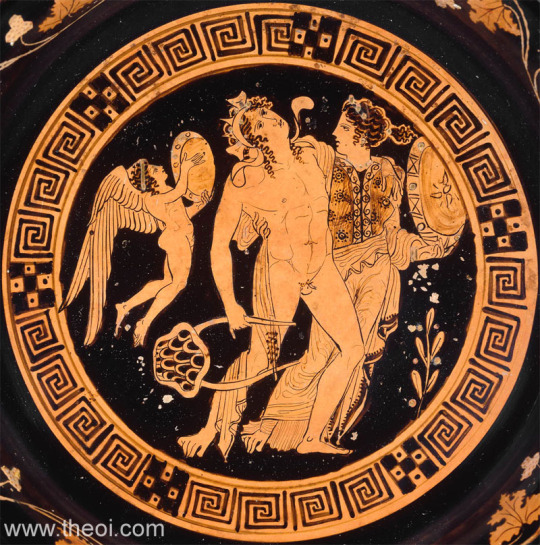
#dionysos#dionysus#greek god#greek gods#mythology#ancient greece#ancient rome#roman religion#greek religion#roman gods#roman mythology#alexander the great#bacchants#pentheus#orphic cult#orphic religion
56 notes
·
View notes
Text

Pythia: Oracle and High Priestess of Delphi Talon Abraxas
Situated on the south-western spur of Mount Parnassus in the valley of Phocis, Delphi was associated with the Greek god Apollo. According to legend, the hill was guarded by a giant serpent called Python, who was a follower of the cult of Gaia (Earth), for hundreds of years. After killing Python, Apollo claimed Delphi as his own sanctuary.
Perhaps this legend was a reflection of actual events. During the Mycenaean period (14th-11th centuries BC), there were small settlements in Delphi dedicated to the Mother Earth deity. Subsequently, the worship of Apollo was established between the 11th and 9th centuries BC. By the 8th century BC, Delphi was already renowned internationally for the prophetic powers of the Pythia. Yet, it was only in the following century that the Oracle became a Panhellenic institution, when Apollo’s advice was sought by the Greek cities on important matters of state.
Pythia was the name given to any priestess throughout the history of the Temple of Apollo at Delphi. The priestess was a woman over 50 years of age who lived apart from her husband and dressed in maiden’s clothes. According to Plutarch, who once served as a priest at Delphi, the Pythia first enters the inner chamber of the temple ( Adyton). Then, she sits on a tripod and inhales the light hydrocarbon gasses that escape from a chasm on the porous earth.
45 notes
·
View notes
Text




A week ago, I went to visit the archeological area of Selinunte located in Sicily. Inside the area, on the Gaggera Hill there are the remains of a sanctuary of Demeter Malophoros.
The place has an ancient open-air altar located in front of the main temple. A canal carved in the rock is located between the altar and the temple carrying water to the sanctuary from a nearby spring. Just past the canal is the Temple of Demeter itself in the form of a megaron lacking a crepidoma or columns, but equipped with a pronaos, naos and adyton with a niche in the back. South of the propylaea, attached to the wall of the enclosure, was another enclosure dedicated to Hecate.
In the northern area there was another enclosure dedicated to Zeus Meilichios and Pasikrateia (Persephone). A very large number of finds came from the Sanctuary of the Malophoros: carved reliefs of mythological scenes, votive figurines in terracotta, large bust-shaped censers depicting Demeter and perhaps Tanit, Corinthian pottery, a bass-relief depicting the Rape of Persephone by Hades and the most ancient statue of Hecate ever found.
It was such a magical experience to visit this ancient and sacred place dedicated to the goddesses I am devoted to.
#paganism#hellenic polytheism#witchcraft#demeter and kore#hecate#selinunte#archaeology#pagan witch#greek temple#history#persephone#sacred places#my pics#sacred space#ancient greece#italianwitch#strega
8 notes
·
View notes
Text
Diviners: what are you reading
Fortune tellers, diviners, tarotists, astrologers, geomancers, bones-throwers, rune-readers... what are you reading??
I’ve heard tell, recently, of someone who got a reading from a Tarot card reader. The client came in with questions about their business.... and the Tarot card reader answered with advice about the gods and spirits, and connecting with the ancestors. They talked in numbers of disks and singular swords, and emperors and Devils.
Umm.
My friend was bewildered. And angry to be out $45. And lacked advice — actionable advice — about how to manage a deteriorating relationship with a business partner.
OK, I get it — I myself have shelves that are bending and sloping under the weight of tarot card decks and books about astrology. I have piles of workbooks and guides to being a better astrologer. And I’m certainly interested in gods and myths and legends of spirits, and how to do magic to make them help you get what you want. If you’re anything like me, THAT’s on your bookshelves, too.
BUT.
I read eight to ten books about business — about sales, about administration, about marketing and advertising, about business design — every year. I read two or three biographies of historical persons (partly to pick them apart for astrological purposes, partly because real people are interesting). I read five to six books about magic, because you have to keep your skills and techniques up-to-date, and know whether or not you’re doing stuff right. I read three or four books about history (ancient and modern) to have examples to draw on in consultations with clients. I read four or five how-to books (and devour YouTube educational content) on sewing, embroidery, woodworking, and more, every year. As my parents (and I) age, I’m reading more books about health and medicine, too.
And because I’m cis-, and white, and straight, and male, I read books by and about and for women, queer people, women of color, men of color. I read books by non-Americans, too, and try to get a sense of the world beyond my state and nation: geopolitics, the economics of South America, the logistics routes that make T-shirts and jeans in the US possible.
In ancient times, the laws of the city of Delphi, home of the most famous oracle in the Mediterranean, simply required that only a woman could sit on the tripod in the adyton and prophesy. By the Classical era, it was required that she be a married woman with children, in her fourth decade — someone who knew something of the world, and knew its pitfalls and challenges, as well as its opportunities.
Please don’t get me wrong — if you’re nineteen, or fifteen, and starting to learn a form of fortune-telling or divination, that’s fine. You don’t have to be married and in your forties to start. You don’t even have to wait for someone to give you a tarot deck or a pack of runes.
But PLEASE —widen the horizon of what’s valuable knowledge for a diviner. It’s not just the official meanings of the cards in the little white book. It’s ALL the other reading and information you’re carrying around in your brain: the things you learned in summer camp about making Friendship Bracelets and the class about computer programming; the obsessive binge-watching of every documentary about China you could find; the map you drew in your journal in math class of who was kissing whom; the lemonade stand you ran with your cousin during the family reunion; the book you borrowed from the library about how to write a novel. Fortune-telling, divination, is a weird method for deciding what information you carry around in your head is relevant to a given conversation with a client or a friend. But feed that head. Locked up inside that head is a treasure-house of experiences, and the more you put in there, the more that you will be able to unfold to a client in the course of a consultation.
61 notes
·
View notes
Text

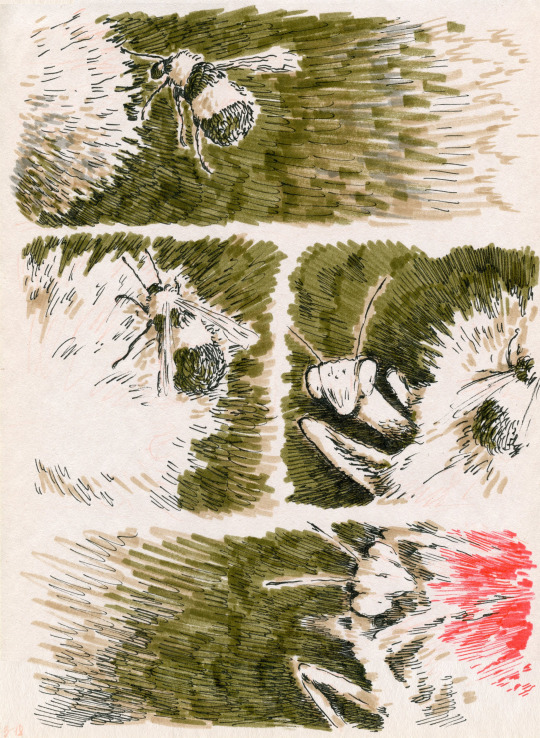
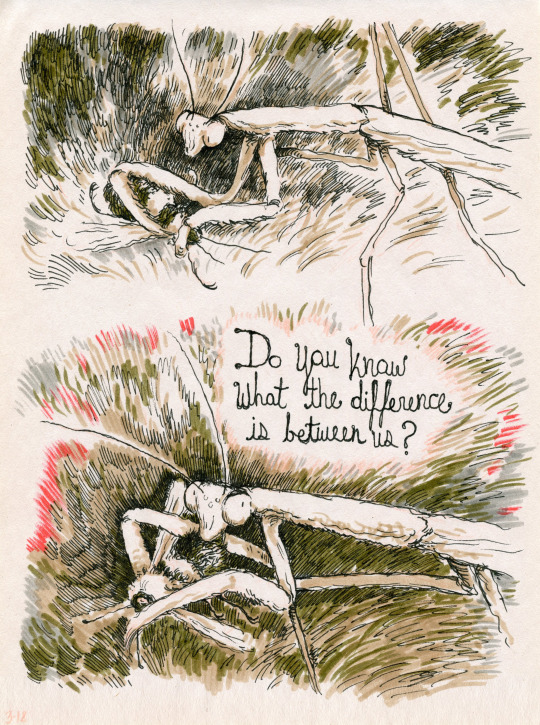
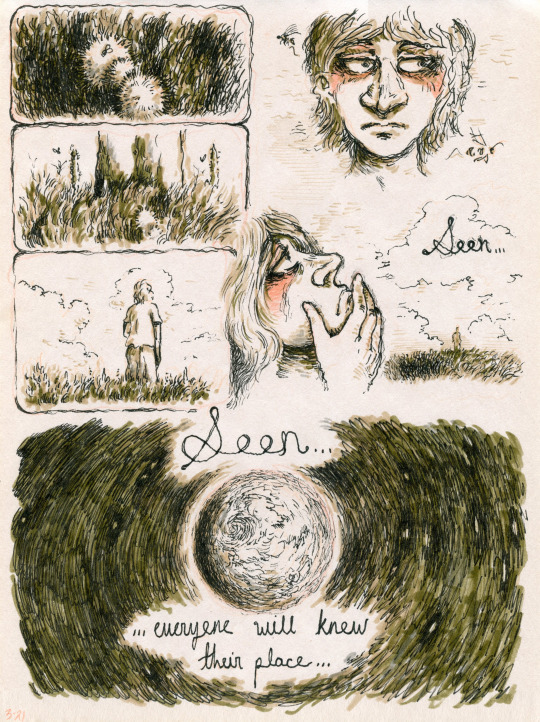
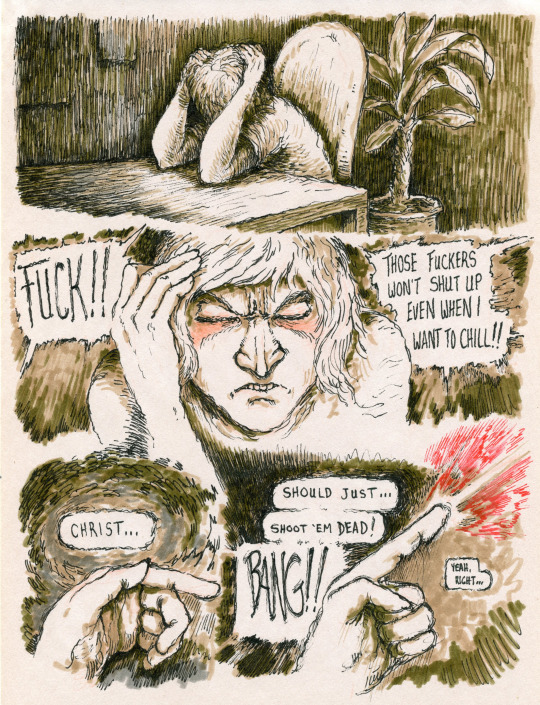

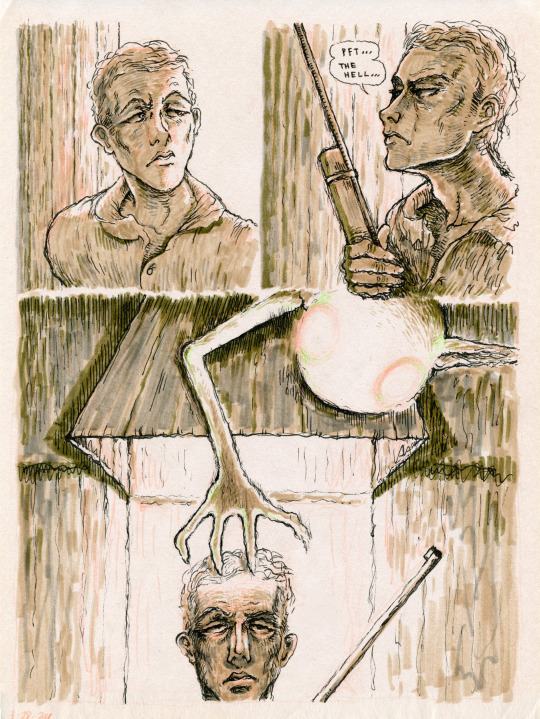
Hey, everyone.
In 2022, I wrote and illustrated a short comic book which I published and sold copies of at that year’s MICE. Entitled Adyton, it was a brief exploration of what I'd very loosely call the close encounter phenomenon, with an emphasis on the abduction aspect. Since then, I’ve wanted to expand on the book; but, as is usual for me, I have to ruminate on something for a long while until embarking on the project feels right. This recently happened, and I’ve decided to entitle what I intend to be my first complete and long-form graphic novel Can You See Behind the Moon? I’m not going to say where the title comes from, and will leave it to those who are more familiar with some of the paranormal literature to recognize its origin.
Over the years, I’ve made sputtering attempts at other graphic novels, but the lack of a clear narrative direction for one doomed it to oblivion (Underbrickers), while the creative momentum of the other seemed bound to a very particular timeframe (Grim Synergy). Differently, I see this project as encompassing ideas which, to varying degrees, are present within my mind every day, or every other day, and I do think it can be sustained by that persistence. If I were forced to speak in very general and perhaps reductive terms about Can You See Behind the Moon?, it is my attempt to explore possibilities implied by close encounters in a way which emphasizes a deep and occulted relationship humanity appears to have with itself, the cosmos, and what one might term the evolutionary impulse.
The first four pages you see here (not counting the cover) are recreations of Adyton’s first six pages. As should be apparent, the narrative is not linear. Like Adyton, the plot sometimes progresses according to visual resonances which can also be interpreted as conceptual resonances. For instance, the as-yet-unnamed young man’s finger-gun gesture becomes the transitional point for a reference to the so-called Kelly-Hopkinsville encounter, wherein guns figured prominently, and unusually.
To be clear, this work has been done very quickly, in the interest of submitting it to relevant publishers as proof-of-concept material, and so that I’m able to maintain a pace of a couple of pages every two or three days (while also producing “fine art” for gallery shows, to say nothing of various other side projects). But I also like the roughness of the drawings, and the color of the newsprint paper… so, the making of these has also carried with it pleasure and occasional surprise at the results. Since I’ve decided to work within a limited palette, I’m relying heavily upon the linework.
For Christmas last year, my partner — somewhat regretfully — got me a comic book about UFOs published the same year by Dark Horse. I write “somewhat regretfully” because she didn’t really like the look of it; and when I received it I had to agree: the art is so simplistic, mundane, and ugly that I don’t think I’ll ever do more than skim some of the pages (the author also seems to have only done the bare minimum of research regarding Betty and Barney Hill’s case). But I’ve used the book as a point of motivation: surely, if something that bland could get green-lit by a fairly well-known comics publisher, then my work stands a chance.
Another one of my particularities is that I tend to get through projects more quickly when I don’t assign their completion an arbitrary date, and also when I don’t make myself beholden to publicizing all of the progress. I don’t intend on making a Kickstarter or anything for this — unless it becomes necessary — so I’m not sure when I’ll be prepared to share more. But, the time will come.
Anyway — even if there’s not much here yet, thanks for looking!
#hudson artist#hudson new york#ufos#aliens#close encounters#flying saucers#graphic novel#paranormal#paranormal phenomena#new comic book#ink illustration#ink drawing
18 notes
·
View notes
Text
Temple - CC-free Community Lot

I made a ancient greek inspired temple community lot.

The temple has the three rooms. A closed Pronaos-like front. Then a cella/naos with the cult statue, and an adyton for the priests.
Download
6 notes
·
View notes
Text
Greek influences in Fall Maiden and Relic of Choice
Just wanted to throw some thoughts about connections between Fall Maiden and her Relic to primarily Apollo and his temple in Delphi.
FALL MAIDEN AND APOLLO:
Apollo is Ancient Greek god of many things: music, dance, healing, archery, but in this theory I will mostly focus on him being god of prophecy. Both major characters that are associated with Fall Maiden power, Pyrrha and Cinder, believe in Destiny. This is an immediate connection to Apollo.
Cinder however, takes connections step further. When observing RWBY from perspective of Pyrrha's literary allusion, Cinder is Paris to Pyrrha's Achilles. There are several parallels between them beyond being just murderer of Achilles character. Both were cast down at birth, Paris being shepherd and Cinder being slave. Both are most prominent archers of their respective stories. Both started a major war (you can even draw a parallel between Paris doing it to have Helen and Cinder doing it to take Maiden power, both being connected to a woman).
Thing with Paris is that he was protected by Apollo. This parallels with Fall Maiden power neatly in the duel between Pyrrha and Cinder. Cinder ends up winning thanks to Fall Maiden power, power that is of divine origin. Paris depending on the version gets either powered up by Apollo to slay Achilles or Apollo outright takes his place. And as I said before, Apollo is god of archery so Cinder being an archer is another parallel.
Paris would end up dying to Philoctetes, which parallels Cinder's encounter with Ruby. Out of four arrows Philoctetes fired, one hit Paris' eye, one his arm, one his heel and one missed. First two match wounds Cinder suffered, heel shot and poison Philoctetes used can be interpreted as Ruby being Cinder's weakness, her Achilles heel. But that's besides the point.
Cinder can also be connected back to Apollo if looking at potential literary allusion like Rhodopis story (more specifically Herodotus version). Rhodopis is basically proto Cinderella story about courtesan being enslaved twice before being freed from slavery by wealthy merchant. At the end of the story, Rhodopis makes a donation to the Apollo's temple at Delphi. This brings me to the next subject.
RELIC AND DELPHI:
It is entirely possible that primary influence of Relic of Choice will be Pythia, high priestess of Delphi Oracle. Object that according to the myths gave Pythia her power of divination is laurel wreath on her head. They believed that Apollo lives within the wreath and shows future to the oracle by rustling its leaves. This parallels what we so far know about Relic of Choice: it's Crown of divine origin that shows user future.
Pythia herself was chosen among influential and skilled local girls, that usually had to be virgins (if not, then they had to abandon their familial duties) following the death of their predecessor. This parallels back to Maidens themselves. Maiden and virgin are synonyms so in both cases it fits the primary holder of the Relic (Interestingly enough Raven is only Maiden that we know for certain wasn't virgin when she was selected and she ended up abandoning her familial duties, similar to Pythia). Maiden powers are also lifelong duty that are transferred upon user's death.
Interestingly enough, when she was working, Pythia descended to adyton, inaccessible area in the temple. This parallels to the Vaults, being hidden areas that can only be accessed by their respective Maiden.
Potential parallel could be Vault's location. If it ends up being in Beacon itself, then Grimm Wyrm that fought alongside of Cinder at the end of Volume 3 becomes interesting parallel. Delphi Oracle was built on the spot where Apollo has slain Python, depending on the version either serpent or draconic creature. So just like Oracle was built where he once stood, petrified Grimm becomes "X marks the spot" for the location of the Vault and the Relic.
LESSON OF A FALL MAIDEN:
I don't think Relic itself will be reliable future seeing device. If it can be used like that, then it becomes Relic of Knowledge, but for future. If it can show future when asked, then it's no longer really about a choice.
In the story of Indecisive King we get some clues how it works. It doesn't show all possible futures, it potentially only centers around choice user makes. Indecisive King only sees the futures in which he is doomed, if it showed all potential futures, than he would have seen the future that was in the story's ending. Reason I say it potentially only centers around one choice is the fact Widow is capable of seeing the future where she is with the King. That future is consequence of her helping the King. So it's possible King himself wanted to see what would have happened if he continued walking his path, while Widow wanted to see the future where she helped the King.
Reason I go over this is uncertainty in Pythia's visions of the future. Of course, we know that they were purposefully ambiguous so it would appear Pythia was right no matter what. They are vague statements that can be interpreted in variety of ways. For example, when Athenians asked her how to defend themselves from the Persians she told them wooden walls would stop them. Some interpreted that as wooden upgrade to existing walls, Themistocles interpreted it as building a navy. In the end Themistocles was right and Athenians defeated Persians in the battle of Salamis. Prophecy itself is meaningless, what matters is the choice you make yourself. I believe Relic in the show will work similar way, show vague vision of the future centered around what you want to see. It is up to you to interpret it and decide what to do.
______________________________________________________________
Last thing I want to focus on is Fall Maiden's lesson in Four Maidens, in universe fairy tale about Maidens. Fall Maiden lesson is moderation, being satisfied with what you already have. This perfectly fits Cinder who's villainy is based around her hunger for power.
There are three maxims inscribed on the temple's pillar at Delphi: Know thyself, Nothing to excess, Surety brings ruin. Fall Maiden's lesson is basically the second maxim, however other two also fit Cinder as a character.
Know thyself fits as she lost her way somewhere between her backstory and he current self. In her backstory she wants to be free, right now while she probably wants the same thing down the line, the way she goes about it have brought her to ruin. No matter what she accomplishes with Maiden powers, she can never be free from Salem. She needs an introspection to realize she walks doomed path.
Surety brings ruin also fits her considering her overconfidence and impulses costed her victory more than once. You can even tinfoil this one since alternate translation is "Make a pledge and trouble is at hand". It pretty much means the same thing since act of making a pledge indicates surety, however as I said, you can tinfoil it. Many people misinterpreted this maxim as making a warning against making any bonds or trusting people. This matches Cinder who is extremely distrustful of others and doesn't have any meaningful emotional connections due to her trauma. You can also tinfoil it harder to mean that because Cinder made a pledge to Salem, she now has literal trouble at hand, her Grimm arm.
______________________________________________________________
Way I see it, looking at Delphian maxims and the way Pythia's prophecies work, I'd say this confirms that whatever happens in the final Vault will be the make or break moment for Cinder's character. She'll either have to look inwards and make the right choice or continue walking a doomed path.
Anyways, what are your thoughts? Feel free to comment if you feel like I missed something or have your own interpretations.
5 notes
·
View notes
Note
Blueprints! I love it when authors make blueprints! It’s so cool to compare what I’ve been seeing in my head with what the author sees in theirs. The main chamber is WAY bigger than I was imagining and for some reason I was picturing the entrance to the catacombs actually inside the bathhouse. Also, when you say the catacombs circle around the temple (I know it would have been very complicated to draw) do they stay level with the temple or do the kind of gradually descend downward toward the room with Kristen’s statue? Like is the room under the main temple or to the side or something? Thank you for sharing the blueprint it’s really cool!
lol yeah the main chamber is a very big space the ceilings are really tall and grand in my head. and no the catacombs entrance is just next to the bathhouse, though I can see why you might get confused on that
the catacombs mostly stay level with the temple! the 'veil' with kristin's smaller statue in it that phil brought wilbur to is actually right behind the adyton. again I didn't add it bc adding the catacombs would've been a Whole Thing, but that room is connected directly to the adyton so phil has easy access to it if he needs a more direct line of prayer to her
17 notes
·
View notes
Text

Today's Flickr photo with the most hits: the adyton of the temple of Apollo at Didyma - one of the great oracular temples of the ancient world. The view is taken close to the great stair that leads to the pronaos.
4 notes
·
View notes
Text
THE ORACULAR GODDESS
THE ORACULAR GODDESS
A short story by Basil Dela Cruz
I swallowed as I stared out the window, the sweet smell of blossoming hyacinths overpowering everything else.
Breathe.
Breathe.
Breathe.
Today was the day I was to become the Oracle, Priestess of Apollo.
“Dearest?”
I turned. “Mother!” I said, forcing a smile.
She returned it. “Oh, my lovely Agathe! Aren’t you so excited? You’re about to become the Oracle! Just like your Ya-ya and me!”
“O-of course! Of course,” I said, my voice tight.
She frowned. “Agathe, why are you acting this way?“ She gasped. “Have the gods not spoken to you?”
“No, Mother! I mean, they have spoken to me!” I replied quickly, though, in reality, it wasn’t true. “I’m just feeling a bit nervous. I am to be shown to hundreds, if not thousands, of people.”
Mother patted my shoulder. “It’s okay, my dear. Now, we must go to the Temple of Apollo. We don’t have all day, you know.”
I nodded, even smiled. “Yes, Mother.”
As we walked down the roads, so bright in comparison to my mood, the words ran in circles in my head.
Liar.
Liar.
Liar.
The gods have not spoken to you.
Liar.
˚₊· ͟͟͞͞➻❥➼˚₊· ͟͟͞͞➻❥➼˚₊· ͟͟͞͞➻❥➼
We reached the Temple of Apollo. As we went through, I rubbed the inscriptions that had always fascinated me:
ΓΝΩΘΙ ΣΑΥΤΟΝ, ΜΗΔΕΝ ΑΓΑΝ , ΕΓΓΥΑ, ΠΑΡΑ ΔΑΤΗ
It used to comfort me, back then.
We met with stern-faced officials and the kind-eyed Pythia I was the apprentice of. We went to the Castalian Spring where people from all around Greece and even non-Greeks waited to prepare for a potential day of prophecy. The current Oracle held out the bowl to me and smiled. All eyes turned to me. I took the bowl with shaking hands and stepped forward. I carefully performed the ritual. I knew this was a tense business. If the goat shivered, then Apollo was willing to be consulted by the travelers that had come from so far away. If the goat did not, the people from afar would have to wait an entire month to consult the Oracle again. Concentrate, Agathe, I thought to myself. I poured the water on the goat.
Everyone waited.
I sent a prayer to the gods, hoping they would answer, though I expected they wouldn’t.
The goat shivered.
The crowd cheered.
Thank the gods.
After all that happened, I became the new Pythia, despite the fact I have not heard a word from the gods.
But that would be my secret, A small voice whispered within me, as the crowds cheered and my parents beamed at me, they faces filled with pride.
Then, on Δευτέρα I learned the true weight of my lies.
A hero came to the Temple of Apollo while I was seated in the adyton on a bronze tripod. He ran in and kneeled in front of me.
“Oh, Oracle of Delphi! Priestess of Apollo!” He cried. “I wish to avenge my father, who met his demise at the hands of my cruel uncle. That accursed man now sits on the throne that should be mine! He has sent me on a quest for the Golden Fleece. Will I succeed? If I do, what will happen after?”
The young man was obviously a hero in the making. If I lied and the outcome was wrong… No. Just give him a prophecy.
“What is thine name, O young man?” I said in the most official and formal voice I could muster.
He looked at me, awe-srtuck, so I assumed I had a good official voice. “Iason, my lady.”
“Well, then, Iason. You will indeed succeed on your quest. I have seen that you will go back to your uncle and he will acknowledge his end of the bargain, though he does so grudgingly. You will have a beautiful wife and children. You will prosper, and live a long life.”
The man smiled. Thank you. Thank you.
˚₊· ͟͟͞͞➻❥➼˚₊· ͟͟͞͞➻❥➼˚₊· ͟͟͞͞➻❥➼
The next month, I wandered through the market during a lazy afternoon, ready to make the proper sacrifices for the gods when I heard snatches and snippets of conversation from whispering women and gossiping girls.
“Oh, do come closer! I have the most interesting of news..” One of the girls drawled.
The women around her leaned in breathlessly to hear.
His old wife brought their children’s demise on an altar.
His new bride and father-in-law burned.
Crushed by the boards of his own ship.
Oh, who was he?
Iason.
She said more, I’m sure, for the women were still leaning towards her like sunflowers do to the sun, but I had stopped listening by then. I ran towards the temple, trying my absolute best not to let the guilty tears flow.
The horror.
The man was dead.
More heroes came. I was unable to do anything else but lie about the outcomes. Tell them what they wanted to hear.
All of their lives ended in tragedy.
When will I be freed of this?
˚₊· ͟͟͞͞➻❥➼˚₊· ͟͟͞͞➻❥➼˚₊· ͟͟͞͞➻❥➼
I was older, much older, than the 13-year-old girl who had become the Pythia. I was sitting there on my bronze stool when a young woman came. She was wearing a cloak of fine wool. I raised my eyebrows at this. Perhaps she didn’t want to be recognized or seen, but why? She stepped forward and kneeled, which I could tell slightly annoyed her. A princess, then.
“Oh, Oracle of Delphi,” She said, her voice low and lovely, “My father’s kingdom is at risk, and I wish to seek guidance so I may assist him.”
I sucked in a breath. I opened my mouth to speak but no words spilled free. I was thinking of the kingdom, a kingdom full of people. I brought curses to any of those who came advice… A curse from the gods for lying, I realized. I could not bear it any longer. I wept and threw myself at her feet.
"Oh dear princess!" I cried. "I am a fake Oracle, and not one to be trusted. Please, find another Oracle! They shall give you better advice than me."
She smiled at me, and a gray aura surrounded her, revealing her true self.
A young woman with chocolate brown curls, cool calculating eyes as big as an owl's, bedecked with armor with her famous bronze shield.
I would have to be a fool to not know her.
Athena.
Before I could collect my thoughts and speak, she said, "You have passed the test, Agathe. Though you have lived a life of deceit, we have given you one last chance to redeem yourself. And redeem yourself you have."
"But why have you given me this chance my lady?" I questioned her, having regained my wits.
"Because you are to be my successor as the goddess of wisdom."
I gaped at her and she smiled.
"Come," She commanded. "You have much to learn as a goddess."
#translation#nah#sorry for not posting#writing#literature#athena#greek mythology#delphi#oracle of delphi#priestess of apollo#apollo#doesn't appear though#idk what tags to use#ill think of something#sorry for not being active#WAIT I ALREADY SAID THAT#woops#hope you like it#agathe#original character#original post#greek gods#ancient greek#greek myths#greek pantheon#ancient greek mythology#how is that not a tag#grief#guilt#she's conflicted
2 notes
·
View notes
Text
ADIVINACIÓN EN DELFOS

La tradición oral y la literatura griega transmiten numerosas respuestas oraculares dadas por la Pitia de Delfos. Por ejemplo, es muy conocida la que cuenta Platón en Apología de Sócrates (21a), cuando Queréfano pregunta a la Pitia si existe algún hombre más sabio que Sócrates y esta contesta que no hay nadie más sabio que Sócrates. El oráculo de Delfos, cuyos orígenes se remontan a finales del s. IX a.C., se acabó convirtiendo en el oráculo más importante del mundo griego. Situado en la región de Fócida, en el centro del mundo griego, el santuario está dedicado al culto de Apolo y, precisamente, está cerca del monte Parnaso, donde la mitología griega ubica el hogar de las Musas, compañeras habituales de este dios. El elemento más importante del oráculo era la Pitia o Pitonisa, una mujer que se mantenía virgen y que era la encargada de manifestar el oráculo que recibía de la divinidad. Pero, ¿cómo se llevaba a cabo la adivinación oracular?
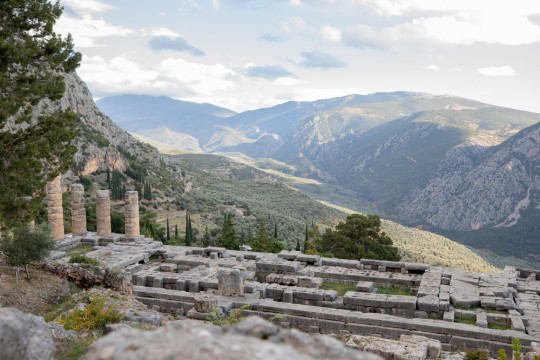
Las consultas al oráculo las hacían tanto las poleis como los individuos particulares, y las respuestas que se ofrecían jugaban un papel esencial en cuestiones tan relevantes como la fundación de colonias o la prestación de ayuda militar. La consulta se hacía en el adyton, la sala que sucede a la nave central de un templo griego. En el adyton del templo de Apolo se encontraban el ónfalo, que señalaba el centro del mundo, y un árbol de laurel, símbolo de este dios. Para obtener respuesta, el que preguntaba debía pagar una especie de peaje conocido como pelanos, que en un primer momento consistía en el ofrecimiento de una torta de sacrificio, de donde toma su nombre este peaje, para luego ser ya una contribución monetaria.

El proceso de consulta tenía varias partes. Primero, en un altar situado fuera del templo se ofrecía un sacrificio preliminar y luego se pasaba al interior del templo, donde se hacía otro sacrificio, depositando partes del animal en la trapeza o mesa de ofrendas situada en la entrada del adyton. Una vez realizados estos sacrificios, la persona que iba a consultar al oráculo era conducida por los intérpretes del oráculo a un espacio donde no podía ver a la Pitia, la cual, dentro del adyton, quemaba hojas de laurel y harina de cebada en el altar (hestia). Después, coronada con laurel, se sentaba en un trípode, entraba en trance y, poseída por el dios, emitía la profecía del oráculo por inspiración divina. Una vez que se expresaba el oráculo, los intérpretes (prophetai) eran los encargados de dar sentido y coherencia a las visiones fragmentarias que había anunciado la Pitia.
Así pues, el santuario de Delfos tuvo una importancia muy destacada no solo dentro del mundo griego, sino que también gozó de gran fama en reinos adyacentes como el de Lidia, en Anatolia. Heródoto (I, 53) nos cuenta que Creso, el rey de Lidia, preguntó al oráculo si podía hacer una expedición contra los persas y que la Pitia respondió que, si lo hacía, destruiría un gran imperio. Esta historia ejemplifica la ambigüedad de las respuestas oraculares dadas en Delfos y la necesidad de interpretarlas correctamente, pues las acciones de Creso sí que pusieron fin a un gran imperio, pero no al persa, sino al lidio.
¿Serías ahora capaz de responder estas preguntas? ¡Mira nuestra siguiente publicación a través de las etiquetas o mediante el link que está en los comentarios!
Bibliografía.
-Scott, M. (2017). Delphic oracle. Oxford Classical Dictionary. https://doi.org/10.1093/acrefore/9780199381135.013.2080
3 notes
·
View notes
Text
Oh wait there's a great flash piece on lightspeed starring Achilles called "You Will Not Live to See M/M Horrors Beyond Your Comprehension" and if the title doesn't convince you...
for a tragedy the iliad is pretty funny. compiled some of my favorite things about it (not in chronological order)
- patroclus barely speaks for most of the book but EVERYBODY loves him. like he’s literally the entire greek camp’s precious meow meow. the ORIGINAL sweet little meow meow. even the GODS are sad and feel bad when he dies. even HOMER loves patroclus, always calling him “faultless patroclus” “my patroclus” “gentle patroclus” “sweet patroclus” WE GET IT. achilles, briseis, menelaus, ajax, literally every member of the greek camp is down ATROCIOUS for patroclus all bc he’s just one Really Nice Dude. just one very Sweet and Polite Fella. one Extra Special Guy <3 his whole narrative purpose is simply to be everyone’s special little scrunkly
- in one of the MANY passages where achilles is lamenting about how sad it is that patroclus is dead he promises patroclus’ corpse that he will have many deep-bosomed trojan and dardanian women weep for him. he tells his dead buddy “i will get the absolute THICKEST hoes with the BIGGEST mommy milkers for your funeral” honestly? id be honored
- all the arguments escalate so quickly. an old man very politely appeals to agamemnon to pretty please give his daughter back and offers him a huge fortune for her and agamemnon calls him a crotchety old bitch and tells him he’ll fucking kill him if he ever sees him again
- that same old man is a priest of apollo. you know, the plague god? anyway priest calls in a favor and apollo curses the greeks with a plague
- to address this, achilles decides to resolve it by calling all the greeks together and passive aggressively going “HM! i WONDER what could have caused a PLAGUE! it’s almost like we OFFENDED the PLAGUE GOD somehow. now WHAT could WE (cough agamemnon) done to offend the PLAGUE GOD?????” all in front of agamemnon
- zeus spends most of the book desperately trying to keep the gods OUT of the war. then once he’s finally had enough he just calls them all together and says “go nuts” and then they do
- artemis talks shit on the battlefield so hera calls her a bitch, steals her bow, and beats her with it. artemis then goes back to zeus and cries
- polydamas says to hector “hey you killed patroclus and achilles is gonna be fucking pissed. we should probably go back to the city while we can” and hector calls him a bitch and tells him to stfu. achilles then chases them back to the city and hector decides to stay outside and get killed by achilles instead of going in with the rest of the army bc he didn’t wanna hear polydamas say “i told you so”
- diomedes is about to fight with a guy called glaucus but then they realize their ancestors were friends or something so they decide not to kill each other, and diomedes says “hey! why don’t we even trade armor! :) just as a show of friendship! :))” and glaucus is like “yeah sure!” and gives diomedes his really nice gold plated armor while glaucus gets diomedes’ shitty plain bronze armor
- achilles makes a bitchy comment to his horses about leaving patroclus to die and the horse momentarily gains the ability to talk just to tell achilles it wasn’t THEIR goddamn fault, tells achilles he’s gonna die soon, and then goes back to being a normal horse.
- zeus with his daughters: oh child ❤️ oh my dear ❤️ oh there there i didn’t really mean it ❤️ sweetie why don’t you go help the greeks?❤️
- zeus with his sons: “ares you fucking donkey”
- everyone calling paris a stupid coward bitch every time they see him. all of troy fucking hates him. hector fucking hates him. helen fucking hates him.
- paris getting dressed up in fancy armor and prancing to the front lines going “i’ll fight ANY of you greeks!” and menelaus (the guy whose wife he stole) goes “alright bet” and paris nearly pisses his pants and tries to hide but then his brother hector calls him a piece of shit and tells him he hopes he dies and makes him fight menelaus. menelaus promptly ROCKS HIS SHIT. literally starts dragging him by his helmet like a rag doll, would’ve killed him if aphrodite hadn’t teleported paris outta there (BOO)
12K notes
·
View notes
Text

The Oracle and I: A Tale of Friendship and Foresight
The soft hum of the wind whispered secrets through the pines atop Mount Parnassus, where the temple of Apollo stood as a sentinel against time. The smell of incense and sacred oils lingered in the air, mingling with the faint, sulfurous scent that wafted from the chasm beneath the temple. This was Delphi, the navel of the world, and I, a simple girl from a nearby village, had the honor—and the burden—of calling the Oracle my best friend.
Her name was not always Pythia. She was born as Kallista, "the fairest," a name as radiant as her spirit. Her laughter once filled the meadows where we played, and her dreams were as ordinary as mine. But destiny rarely favors the ordinary.
Kallista was chosen, plucked from our simple lives by priests who claimed Apollo himself had guided their decision. “She is the one,” they said, their voices thick with reverence. She was to serve as the mouthpiece of the god of prophecy.
I still remember the day she left. Her face was a canvas of fear and hope, and she held my hand tightly as we said our goodbyes. “Promise you’ll visit,” she whispered, her voice trembling like the olive leaves in the wind. I nodded, swallowing the lump in my throat, not knowing how much this role would demand of her.
The Trials of Pythia
Becoming the Oracle was not as glorious as the tales suggested. Kallista was cloistered, stripped of her identity, and thrust into a world of ritual and duty. She fasted, prayed, and prepared her body and mind to channel the will of Apollo.
When the time came, she was led to the adyton, the sacred inner chamber of the temple. She sat on the tripod above the chasm, the very breath of the earth rising to meet her. I was permitted to watch from the shadows as her body convulsed and her eyes clouded over. She spoke in riddles, her words fragmented but profound. The priests interpreted her utterances for the supplicants who came from far and wide, seeking answers to questions both grave and trivial.
But these moments took their toll. The visions left her exhausted, her body fragile and her spirit wearied. “It is not Apollo’s will I fear,” she confided to me one evening, her voice barely above a whisper. “It is the weight of their hopes and fears. They place their lives in my hands, and yet I am only human.”
The Burden of Prophecy
As her fame grew, so did the demands upon her. Kings and warriors sought her guidance before battles; farmers asked for blessings upon their crops. Her words could alter the course of nations, but the cost to her was immeasurable.
One day, a powerful warlord came seeking her counsel. His arrogance was palpable as he demanded to know whether he would emerge victorious in his conquest. Kallista, now fully immersed in her role as Pythia, entered her trance. Her response was cryptic: “A great kingdom shall fall.”
The warlord departed, confident in his triumph. Yet, when the dust of battle settled, it was his own kingdom that lay in ruins. Furious, he returned, accusing her of deceit. “I spoke only the truth as Apollo revealed it,” she said, her voice steady but her eyes betraying her anguish.
The Trials of Friendship
I remained by her side, my role as her confidante both a blessing and a curse. I saw the toll her gift took, the isolation it imposed. Her laughter became rare, her joy eclipsed by the weight of her role. Yet, even in her darkest moments, she carried herself with a dignity that inspired all who knew her.
One evening, as we sat beneath the stars, she took my hand. “Do you think I chose this life?” she asked, her voice heavy with emotion. “Do you think I wanted to be the vessel for a god’s will? Yet, here I am. Perhaps it is not about what we choose, but about what we make of what is chosen for us.”
The End of an Era
Kallista’s years as Pythia came to an end as the world around us changed. The rise of new religions and the decline of the old ways dimmed the temple’s once-brilliant flame. She returned to our village, no longer the Oracle but simply Kallista once more. Yet, the wisdom she had gained remained.
In her final days, she shared her greatest lesson: “Prophecy is not about knowing the future. It is about understanding the present and acting with courage and integrity. Each of us carries the power to shape our destiny.”
Moral of the Story
Kallista’s life taught me that greatness is not in the roles we are given but in how we rise to meet them. She bore the weight of her calling with grace and courage, reminding us that even the humblest of us can be the vessel for something divine.
To this day, I honor her memory, not as the Oracle of Delphi, but as my friend, whose trials and triumphs were a testament to the strength of the human spirit.
1 note
·
View note